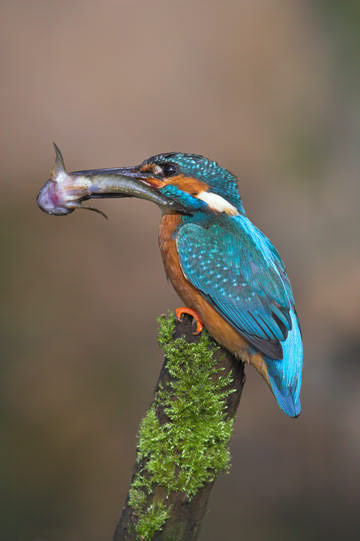
Kingfisher © Simon Booth
The winter map shows that Kingfishers are more widespread in winter than when breeding, being present in both seasons in 114 tetrads, in winter only in 93, while they were not recorded in 55 tetrads in which they spent the breeding season. Few birds move very far, but juvenile dispersal may take birds a few kilometres, sufficient to visit almost any suitable water in the county. There are recent examples of ringed young birds in autumn moving 32 km from Congleton (SJ86L) to Woolston (SJ68U), and 11 km from Woolston to Oxmoor, Runcorn (SJ58M), with one exceptional bird ringed at Woolston in June and found six months later 60 km away in Staffordshire.
The wider distribution in winter in part comes from birds occupying a wider range of habitats: they are still tied to water, of course, and need suitable perches from which to look for fish, but they no longer have to find vertical banks nearby. More birds were found using standing waterbodies than in the breeding season, with the ratio of linear watercourses to areas of standing water shifting from 62%: 38% in the breeding season to 55%: 45% in winter. There is a higher proportion on canals (14% in winter, 11% in the breeding season), these often having enough fish but impenetrable brick sides, unsuitable for nesting. All of these differences are relatively small, however, and clearly many Kingfishers live all year round in the same site.
Kingfishers are vulnerable to hard winters, when freshwaters ice over, and many birds die while some move to the estuaries or seashore to find unfrozen fishing areas. Bell (1962) noted that in hard weather they may be driven to the coastal marshes and gutters. There have been no prolonged sub-zero spells since the 1980s, however, and birds were found in this Atlas in only two tetrads recorded as estuarine, in Stanlow Bay (SJ47D) and Wigg Island (SJ58G) in the tidal river Mersey.
The annual county bird reports mostly seem to receive records from the east of Cheshire and along the River Dee, but this winter Atlas map shows that this is probably an artefact of observers’ locations, with Kingfishers widely spread throughout the county, although with the thinnest distribution on Wirral and SJ37/ SJ47/ SJ57. Individual birds moving along a winter feeding area might exaggerate the picture somewhat, with an extreme example in SJ37S/ T/ X/ Y where Mike Gough noted that one bird wintered on a 1 km stretch of Rivacre Brook which runs through all four tetrads. In some tetrads there may be several birds, although of the 269 records submitted over the three years, only 21 were of more than one bird, illustrating that many Kingfishers maintain territories for winter feeding. There could well be 500 or more birds, widespread across the county in midwinter; the species probably fits Coward’s assessment a century ago of ‘widely distributed but nowhere abundant’ (Coward 1910).
Sponsored by Mid-Cheshire Ornithological Society

